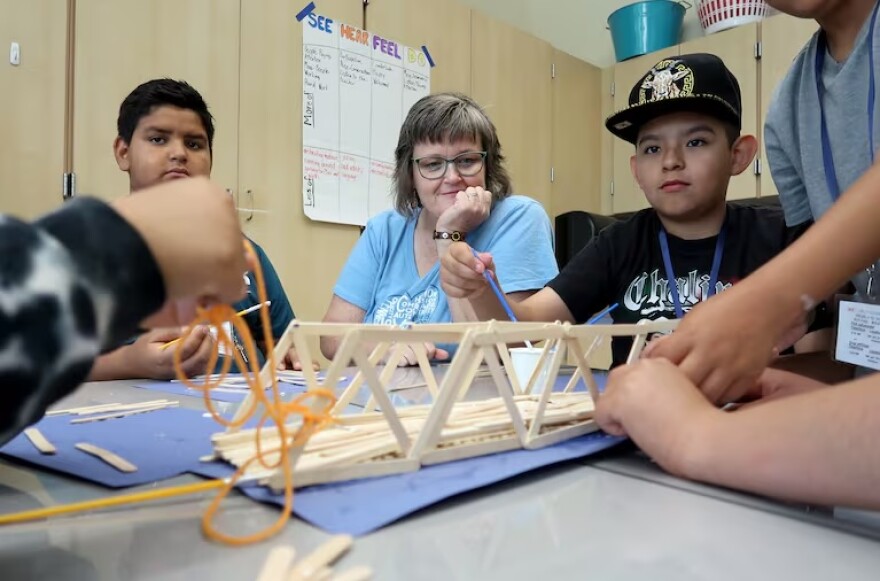Angelica Alaniz sat on a speckled carpet at Imlay Elementary School in Hillsboro with three soon-to-be second graders one late July morning.
“Put our eyes up here now, ready?” she prompted the students. “We’re gonna practice the letter ‘s.’ Can I hear that sound?”
The three girls — sitting crisscross applesauce next to Alaniz, mini whiteboards in their hands — responded back one after the other: “Ss. Ss. Ss.”
“Good,” Alaniz said. She pointed to the projected screen before them, with the title banner across the top: “Let’s read together.” The screen displayed half a dozen short words — is, as, fans, bugs, bags and pans — which they read together as a chorus.
“Sometimes after an ‘n’ or a ‘d,’ the ‘s’ is not gonna make …,” she paused and started again, “you know what it’s gonna make? It’s gonna make the sound ‘zzz.’ Yes, you remember! Zzz, like zipper.”
During the regular school year, Alaniz works as a first-grade teacher at Witch Hazel Elementary School just across town, where she’s part of a dual language program, instructing in Spanish and English. But that July morning, Alaniz was teaching reading as part of a bilingual summer program at Imlay Elementary.
Hillsboro School District provided such programming to more than 2,800 students this summer, district officials said, thanks largely to funding support from the state. Hillsboro is one of dozens of districts to get this money.
Oregon lawmakers invested an additional $30 million into summer learning this year when they passed House Bill 4082.

The total was more than schools got the year prior — when lawmakers failed to allocate any additional funding — but less than the $50 million the bill’s chief sponsor, state Rep. Susan McLain, D-Hillsboro, and Gov. Tina Kotek wanted. It was also significantly less than the money allocated for summer learning in the years immediately following pandemic school closures.
The funding for this summer was to be split among roughly 200 school districts, charter schools and education service districts across the state. Priority was meant to go to Title I schools, which serve higher proportions of children with risk factors like poverty or who move around a lot.
The idea was that summer learning grant money would focus on serving historically underserved students while prioritizing collaboration with community partners, local governments and tribal nations.
While not every school received all that they wanted, the funding allowed more students, as the state put it, to participate in “innovative and inclusive educational opportunities this summer.”
More than 60 education providers received some share of the money, including 43 school districts and 13 education service districts partnering. They joined with more than 130 community organizations, directly impacting more than 50,000 K-12 children statewide.
Hillsboro received about $1.5 million.
“These summer programs give our students who are most in need of support the opportunity to strengthen their skills and position themselves for enhanced success in the coming school year,” said Brooke Nova, an assistant superintendent in the district, in a news release.

Not every district received money. In fact, some major districts, including Oregon’s largest K-12 system, Portland Public Schools, remained on the waitlist.
It’s also too soon to tell whether the added investments and programs affected student learning, and whether achievement, often measured on standardized tests, might have improved after taking a hit during the pandemic.
However, proponents, including Gov. Kotek and Oregon Department of Education Director Charlene Williams, say they’re already seeing a lot of positive signs. Williams, along with Sen. Janeen Sollman, D-Hillsboro, and several other education and elected officials, toured Imlay’s bilingual summer programs last month.
Williams said she’s seen an “all hands on deck” approach across schools. She listed successful examples to learn from, too. For example, she’s visited some, including Imlay, that use “grow your own” programs where recent graduates become teachers and help students over the summer. Other programs she highlighted focus on hands-on learning or emphasize skills with significant career opportunities, such as fields related to STEM, or science, technology, engineering, and mathematics.
“Research shows when students engage in summer learning, we have increased outcomes in both academics and attendance and overall connection to school,” Williams said.

Kotek agreed that summer and after-school learning is an important tool that Oregon has and should be utilizing more. But she also said these pieces are just part of the larger puzzle to improve the state’s overall education system.
“It’s not just about summer. It’s not just about after school. It’s making sure the conditions in our schools are such that our students can be successful,” Kotek said, “that they feel connected, that they feel that they belong, that they have caring, trusted adults in their schools and in community programs that can help them be successful on their educational journey.”
In the coming months, state officials plan to analyze best practices from this summer and follow up with recommendations to lawmakers.
Some educators are concerned about relying too much on one-time funding following a school year rife with budget cuts and layoffs.
Kotek has taken a step toward addressing those concerns — and other money issues facing schools — by proposing a change to how the “current service level” for the state’s education budget is calculated. Her office estimates her changes would lead to an increase of about $515 million in the State School Fund for the 2025-27 biennium, as previously reported by OPB.
“At the end of the day,” Kotek said at a recent press event talking about summer and after-school learning, “whether you’re doing a summer program or literacy program or just opening the doors every day for our students, you need stable and predictable funding, and we need to see the outcomes that go along with those resources.”
Copyright 2024 Oregon Public Broadcasting


